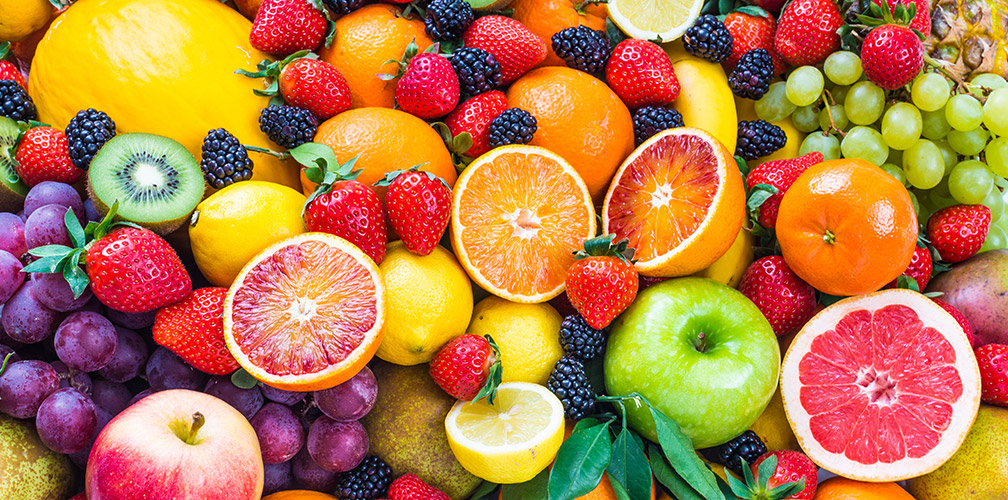Fructose
Fructose is a monosaccharide naturally present in fruit, vegetables and honey. When combined with glucose, it forms sucrose, commonly known as sugar. The physical and chemical properties of fructose appeal to the food industry, which produces it from cornflour. Even though fructose is just as calorific as glucose, our body metabolises them differently. Recent studies have focused on the potential effects of fructose on health.
Constitutive unit of sucrose
Fructose is a monosaccharide, a simple sugar also called ‘fruit sugar’. It is naturally present in fruit (including berries), vegetables and honey. Fructose is combined with glucose to form sucrose or table sugar. The proportion of fructose varies considerably from one kind of fruit to another: 100 g of apples contain 6.0 g of fructose (56% of the total sugar content), while the same weight of apricots contains only 1 g of fructose (11% of the total sugar content). It is important to note that the proportions of the different sugars (fructose, glucose, sucrose) also vary depending on how ripe the fruit is.
The role of fructose in the food industry
The physical and chemical properties of fructose make it particularly interesting for the food industry. It is hygroscopic, meaning it attracts water, favours condensation and is very soluble at low temperatures. It therefore serves as a good humidifying agent for baked goods, biscuits and confectionery.

From the 1970s, the American food industry replaced sucrose by a high fructose syrup derived from cornflour. With greater sweetening power than normal cane or beet sugar, this corn syrup comprises a mix of glucose and fructose, which is why it is also called ‘glucose-fructose syrup’ or ‘isoglucose’. From a technical point of view, the starch serves as a basis for the extraction of glucose, part of which is then transformed into fructose by an enzyme reaction. The proportion of fructose can reach 90%, but is generally somewhere between 40% and 60%. The most common versions contain between 45% and 55% fructose, known in the United States as HFCS-45 and HFCS-55.
Calorific value, metabolisation and effects on health
The high sweetening power of fructose bears no relation to its caloric value. In fact, in equal quantities, fructose provides as much energy as all other sugars, i.e. 4 kcal per gram.
This monosaccharide enters the bloodstream via the small intestine. The liver then transforms it into fatty acid (10% of the fructose ingested), glucose (50%), lactate (15%) or glycogen. Unlike glucose, the metabolism of fructose is not regulated by insulin and is less effective at triggering feelings of satiety. Today’s scientific studies focus on the excessive consumption of fructose and its effects on health. According to statistics, an inhabitant of the United States eats on average 55 g of fructose a day. Current research suggests that a daily consumption in excess of 50 g raises the level of lipids in the blood (triglycerides).
GARRET, Reginald H. GRISHAM, Charles M., 2000. Biochimie. Torino. De Boeck Université.
REECE, URRY, CAIN, WASSERMAN, MINORSKY, JACKSON, 2012. Biologie. Canada. Pearson
SENSER, F, 1991. Der kleine « Souci-Fachmann-Kraut ». Stuttgart. Wissenschaftliche Verlagsgesellschaft mbH
TRAN, Christel, TAPPY Luc, 2012. Sucrose, glucose, fructose: quels sont les effets du sucre sur la santé métabolique? Rev Med Suisse, vol 8, n331, p513-518 Disponible à l’adresse : https://www.revmed.ch/RMS/2012/RMS-331/Sucrose-glucose-fructose-quels-sont-les-effets-des-sucres-sur-la-sante-metabolique
USDA-ERS, 2011, Sugar and Sweeteners Outlook/SSS-M-272: World Sugar and High Fructose Syrup Production Costs: 2000/01-2009/10, Economic Research Service, 27 pp (https://www.ers.usda.gov/mediaImport/572790/sssm272_1_.pdf#page=13)
CASEY, J. P. High fructose corn syrup. A case history of innovation. Starch‐Stärke, 1977, vol. 29, no 6, p. 196-204.
WHITE, John S. Straight talk about high-fructose corn syrup: what it is and what it ain't. The American journal of clinical nutrition, 2008, vol. 88, no 6, p. 1716S-1721S. (http://ajcn.nutrition.org/content/88/6/1716S.full)
LOWETTE, Katrien, ROOSEN, Lina, TACK, Jan, et al. Effects of high-fructose diets on central appetite signaling and cognitive function. Frontiers in nutrition, 2015, vol. 2, p. 5. doi: 10.3389/fnut.2015.00005 (https://www.ncbi.nlm.nih.gov/pmc/articles/PMC4429636/pdf/fnut-02-00005.pdf)







